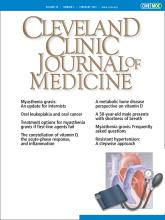
Myasthenia gravis (MG) is an uncommon neuromuscular disorder with an estimated prevalence likely under 1 per 10,000. But knowing some of its clinical characteristics and considering it in the differential diagnosis pushes me to probe deeper into the nuances of a patient’s historical narrative when they list fatigue or weakness as a symptom.
MG is an autoimmune disease characterized pathobiologically by the presence of antibodies that recognize components of the muscle side of the neuromuscular junction end plate. The initially recognized and most common target for these antibodies is the acetylcholine receptor (AChR). Unlike common autoimmune conditions with their associated antibodies such as lupus (antinuclear antibodies) and rheumatoid arthritis (rheumatoid factor), the antibodies associated with MG are directly pathogenic. Recognition of the pathophysiologic anti-AChR effect of these antibodies led to the still utilized therapeutic strategy of overcoming the antibody-mediated receptor blockade by increasing the concentration of the receptor’s agonist acetylcholine by slowing its metabolism using inhibitors of acetylcholinesterase. But there is more to the effect of these and other pathogenic antibodies on the progression of MG than simply interfering with the binding of acetylcholine to its cognate receptor.
MG is rare in any internist’s clinic, even for subspecialists who focus on patients with symptoms relating to musculoskeletal and respiratory muscle function. Recognizing the spectrum of MG patients’ verbalized complaints hones our clinical reasoning skills when faced with the commonly expressed symptom of “fatigue.” Clinical and electrodiagnostic fatigability is a hallmark of MG, but that is not how patients are likely to describe their symptoms. As we try to discern between fatigue and sleepiness, fatigue and muscle weakness, fatigue and lack of desire, and weakness and pain, keeping MG in mind as a diagnostic possibility forces us to more deeply explore the symptom domains of muscle fatigue and weakness. Asking the patient if symptoms are dramatically worse at the end of the day or after repetitive but seemingly mild exertion (brushing hair) becomes relevant. Does the patient or those who spend time with the patient notice drooping eyelids or head with prolonged driving or reading, or a more muffled or nasal quality to the voice with prolonged speaking? Has the patient noticed the odd sensation of shortness of breath when lying down? Unlike with some other myopathies, initial static strength testing in the office or measurement of the creatine kinase may not be strikingly abnormal.
Morren and co-authors in 2 papers in this issue of The Journal1,2 discuss the diagnosis of MG and some of the nuances of treatment.
While the vast majority of patients with MG have detectable antibodies to the AChR, others harbor antibodies against other proteins that affect the function of the neuromuscular junction. Some patients with milder disease may have an adequate response to physiologic therapy that increases the concentration of acetylcholine within the neuromuscular junction using medications such as pyridostigmine. Many, however, will require immunosuppressive therapy directed at reducing the concentration of the pathogenic antibodies. In about 15% of patients, the disease is relatively refractory to available therapies. As with other autoimmune diseases, corticosteroids are a cornerstone of initial therapy with the goal of reducing the pathogenic antibody concentration as well as any inflammatory response triggered by the binding of the antibody to the muscle cell’s membrane proteins (including the AChR). Binding of the AChR antibody to the muscle cell triggers internalization of the receptors and also activates complement, resulting in disruption of the specialized junction cellular structure, promoting cell damage and progression of the disease. This observation has been exploited by the successful use of complement-inhibiting drugs to treat patients with MG, even those who may have had a suboptimal response to the commonly used immunosuppressive therapies (eg, mycophenolate, azathioprine, methotrexate). Drugs targeting the fifth component of complement (C5) have been approved by the US Food and Drug Administration for the treatment of generalized MG.3 A smaller subset of patients with clinical MG have clinically measurable antibodies against a muscle-specific kinase (not the AChR). These antibodies seem to be unique to the immunoglobulin (Ig) G4 subclass. IgG4 antibodies do not activate complement, and patients with this subset of MG, as noted in this issue by Morren and Li,1 clinically behave somewhat differently. Fortunately, as do patients with the clinically distinct IgG4-related disease, these patients tend to respond robustly to anti-B-cell agents such as rituximab with a decrease in the production of the pathogenic antibody. Thus, serologic characterization has both diagnostic and therapeutic implications.
Two clinical scenarios experienced by patients with MG warrant our awareness. Occasionally, with initiation of corticosteroid therapy, the myasthenic symptoms of weakness markedly and paradoxically worsen. Recognizing this phenomenon should immediately trigger discussion with our neuromuscular colleagues, as “steroid myopathy” is not an acute event occurring at the start of corticosteroid treatment. The second scenario relates to worsening of myasthenic symptoms with use of some medications. The list of potential aggravating medications is long, but relatively few medications warrant true avoidance in the MG patient whose disease is under good control.1 However, caution should be paid particularly to prescribing antibiotics including aminoglycosides, fluoro quinolones, and some macrolides.
- Copyright © 2023 The Cleveland Clinic Foundation. All Rights Reserved.






